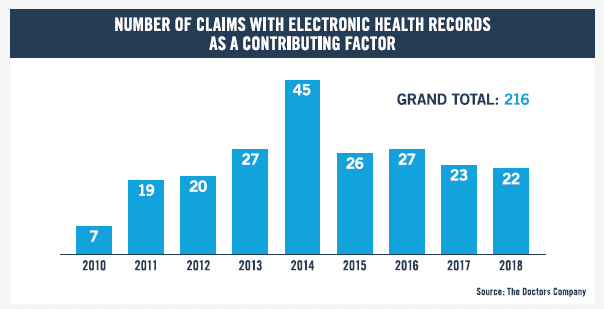Sep 15
2019
Electronic Health Record Data Show Concerns Continue Over Injury Claims
As provider adoption of electronic health records (EHRs) approaches near-universal levels, a study from The Doctors Company shows the frequency of claims in which EHRs contributed to injury continues to rise.
 Analyzing EHR-related medical malpractice claims that closed between 2010 and 2018, The Doctors Company uncovered that the pace of these claims tripled, growing from a mere seven cases in 2010 to an average of 22.5 cases per year in 2017 and 2018.
Analyzing EHR-related medical malpractice claims that closed between 2010 and 2018, The Doctors Company uncovered that the pace of these claims tripled, growing from a mere seven cases in 2010 to an average of 22.5 cases per year in 2017 and 2018.
While EHRs are not often the primary cause of claims, the study shines a light on potential risks they may pose in care delivery, as well as the top factors that contributed to the claims. The study showed that EHR-related claims were caused by either system technology and design issues or by user-related issues. Among the top findings:
- Top user-related issues stem from incorrect information, pre-populating or copying and pasting, and hybrid health records or EHR conversion.
- Top system technology and design issues were problems with electronic systems and technology failure.
- Of those injuries that occurred in 7 percent or more of claims, adverse reaction to a medication and death were by far the most prevalent.
- Diagnosis-related allegations represented nearly one-third of the total.
- Two specialties—family medicine and internal medicine—received the highest percentage of claims where EHRs are a factor, followed by cardiology and radiology.
Based on this data, study author Darrell Ranum, JD, CPHRM, vice president of patient safety and risk management at The Doctors Company, identified the following steps to prevent EHR-related risks that may ultimately contribute to an adverse event:
- Avoid copying and pasting except when describing the patient’s past medical history.
- Contact your organization’s information technology (IT) department or your vendor if you notice that the auto population feature causes erroneous data to be recorded. If the auto-populated information is incorrect, note it and document the correct information.
- Review your entry after you make a choice from a drop-down menu. Templates with drop-down menus facilitate data entry, but an entry error may be perpetuated elsewhere in the EHR.
- Review all available data and information prior to treating a patient—injury may result from failure to access or make use of available patient information.
- Relocate the computer so the physician’s back is not to the patient and so the patient can view the screen. Remind the patient that you are listening carefully, even though you may be typing during the appointment, and summarize or read the note to demonstrate you have listened.
“The Doctors Company began analyzing the impact of EHRs on medical malpractice claims as early as 2010, being one of the first insurers to look into this important issue,” said Ranum. “What we have discovered is that allegations of injuries where EHRs are a factor, while a small percentage of overall claims, continue to be a concern as the potential for harm can be catastrophic. Practices should have processes in place to monitor EHR issues and prioritize the need for EHR improvements and redesign based on risk.”